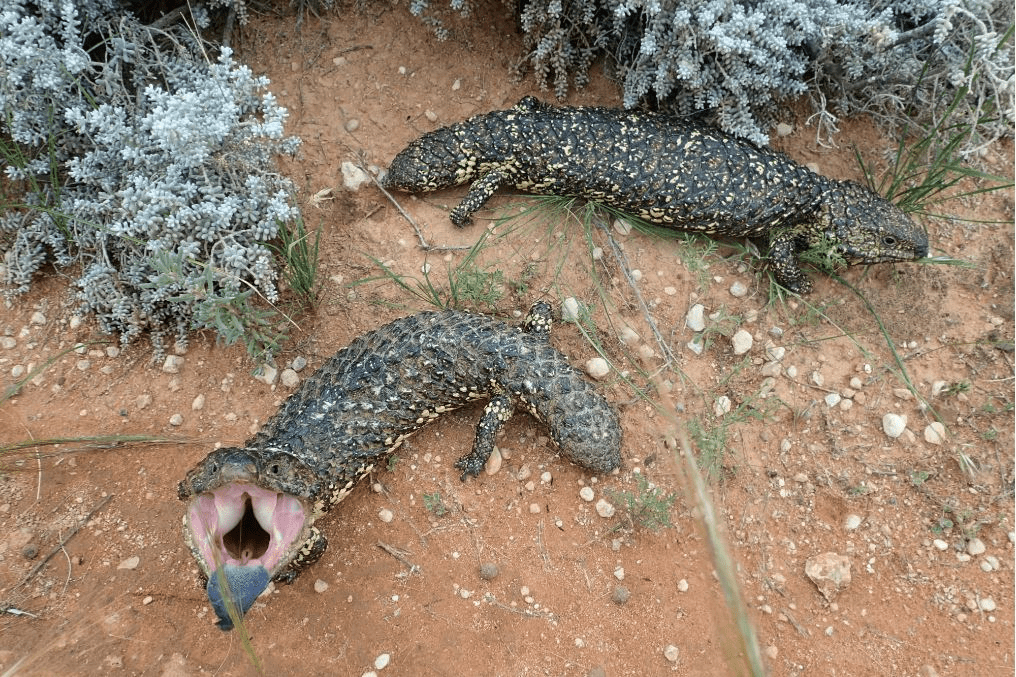A newly described species of skink was 1,000 times heavier than the typical member of that family. The largest known skink went extinct 47,000 years ago, at the same time as many other Australian giants were dying off. The discoverers believe there are plenty more giant skinks from the same era waiting to be identified, and the delay in describing this one reflects the neglect of Australia’s fossil reptiles.
The typical garden skink weighs about 2 grams (0.07 ounces). Like other continents, Australia has a lot of them, but it also has something else: big slow members of the skink family like blue-tongued lizards and shinglebacks, the largest of which weigh 1 kilogram (2.2 pounds).
Proceedings of the Royal Society B caries the announcement of the extinct species, Tiliqua frangens, which was bigger yet, estimated to have reached the size of an adult human’s forearm and weighed 2 kilograms (4.4 pounds). So hefty was the beast that palaeontologists working on it have given it nicknames like “Mega Chonk” and “Chonkasaurus” (not to be confused with Chonkosaurus, Chicago’s giant snapping turtle).
Dr Kailah Thorn from the Western Australian Museum told IFLScience that most of the 1,700 living skink species rely on speed and camouflage to avoid becoming someone’s dinner, along with the whole tail-dropping thing. Frangens obviously had a very different approach, being covered by heavy armor and spikes.
Indeed, it was these that alerted the authors to Frangens’ existence. “In the dig at Wellington Caves, we started finding these spiked armoured plates that had surprisingly never been recorded before. We knew we had something interesting and unique,” Dr Diana Fusco of the Flinders University Palaeontology Laboratory said in a statement.
Australia has no land turtles, and the authors think Frangens filled a similar niche, using its wide mouth to feed on leaves and literally low-hanging fruits, while being too tough for most predators to handle. Constricting snakes would have been among the threats to a slow-moving reptile this size and as Thorn noted to IFLScience: “It would be uncomfortable to constrict those spikes.” Other possible threats might have included marsupial lions and very large raptors.

Two shinglebacks, the closest living relative to T. frangens at about half their size.
Image Credit: Mike Gardner, Flinders University
Frangens were present in Australia at least a million years ago, and one tentatively dated specimen was probably in the 1.5-2 million-year-old range. This makes it hard to miss the timing of their extinction, very close to the point where people first spread out across the continent.
Thorn is avoiding the famously nasty debate about what killed the Australian megafauna, saying more data is needed, but acknowledges that if Frangens were tasty, their defenses may have been little use against tools and fire. Alternatively, the extinction of so many larger species around the same time may have changed the ecosystem in a way Frangens couldn’t adapt to.
Thorn noted that large, long-lived species are “the weakest link trophically” in the face of rapid change. “The fact the big ones went extinct even though they’re not as big as the megafauna shows you don’t need to be more than 100 kilograms (220 pounds) to be vulnerable,” she told IFLScience.
The paper notes that even though Frangens appear to have been widespread, there is no evidence of them coinciding with shinglebacks, even though many of these locations are now home to the smaller relative. Thus it seems Frangens’ extinction may have opened a door for the species many called sleepy lizards.
Bones of several other giant skinks have been found, and one of these might even have been longer than Frangens, but no one has yet put enough of these together to describe the other lost species.
The study is published in Proceedings of the Royal Society B.
Source Link: Meet The Giant Armored Fossil Skink Twice As Big As Largest Surviving Species